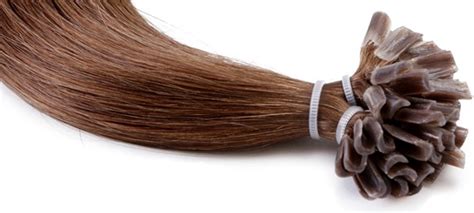Introduction
Glue-in extensions are a popular hair extension method that involves attaching donor hair to your natural hair using a special type of glue. This method is often used to create volume, length, or a change of color. While glue-in extensions can be a great way to achieve your desired look, it is important to do your research before getting them installed.

Types of Glue-In Extensions
There are two main types of glue-in extensions:
- Keratin glue-in extensions: These extensions are made from human hair that has been coated with keratin, a natural protein found in hair. The keratin glue is melted and applied to the base of your natural hair, where it bonds to the cuticle. Keratin glue-in extensions are a good option for people with fine or thin hair, as they are less likely to damage your natural hair.
- Polyurethane glue-in extensions: These extensions are made from synthetic hair that has been coated with polyurethane, a type of plastic. Polyurethane glue is less damaging to hair than keratin glue, but it can be more difficult to remove. Polyurethane glue-in extensions are a good option for people with thick or coarse hair.
Benefits of Glue-In Extensions
- Versatile: Glue-in extensions can be used to create a variety of looks, from subtle to dramatic.
- Long-lasting: Glue-in extensions can last for up to 6 months with proper care.
- Low-maintenance: Glue-in extensions are relatively low-maintenance. Once they are installed, you can wash and style your hair as usual.
Drawbacks of Glue-In Extensions
- Can damage hair: Glue-in extensions can damage your natural hair, especially if they are not installed or removed properly.
- Time-consuming: Glue-in extensions can take several hours to install and remove.
- Can be expensive: Glue-in extensions can be expensive, especially if you have long or thick hair.
How to Get Glue-In Extensions
If you are considering getting glue-in extensions, it is important to consult with a professional hair stylist. They can help you choose the right type of extensions and ensure that they are installed correctly.
Here are the steps involved in getting glue-in extensions:
- Your hair will be washed and blow-dried.
- The stylist will section your hair and apply the glue to the base of your natural hair.
- The stylist will press the donor hair into the glue.
- The stylist will trim and style your hair.
How to Care for Glue-In Extensions
To keep your glue-in extensions looking their best, it is important to follow these care instructions:
- Wash your hair with a sulfate-free shampoo and conditioner.
- Avoid using heat styling tools on your extensions.
- Brush your hair gently to avoid tangles.
- Sleep on a silk pillowcase to prevent friction.
- Get regular maintenance appointments with your stylist.
Troubleshooting Glue-In Extensions
If you are experiencing any problems with your glue-in extensions, it is important to consult with your stylist. They can help you identify the problem and find a solution.
Here are some common problems that you may encounter:
- Shedding: Glue-in extensions can shed, especially when they are first installed. This is normal, but if you are experiencing excessive shedding, it may be a sign that your extensions are not installed correctly.
- Matting: Glue-in extensions can become matted if they are not brushed regularly. Matting can cause the hair to break, so it is important to brush your extensions gently every day.
- Tangling: Glue-in extensions can become tangled if they are not brushed regularly. Tangling can cause the hair to break, so it is important to brush your extensions gently every day.
- Dandruff: Glue-in extensions can cause dandruff if they are not washed regularly. Dandruff is caused by a buildup of dead skin cells on the scalp. To prevent dandruff, wash your hair with a sulfate-free shampoo and conditioner.
- Itching: Glue-in extensions can cause itching if they are not installed correctly. Itching is caused by the glue irritating your scalp. To prevent itching, make sure your extensions are installed by a professional.
Conclusion
Glue-in extensions can be a great way to achieve your desired look. However, it is important to do your research before getting them installed. By following these tips, you can keep your glue-in extensions looking their best and avoid potential problems.
Additional Tips
- If you are new to glue-in extensions, it is best to start with a small number of extensions. This will give you a chance to get used to the feel and look of the extensions before committing to a full head of hair.
- Be sure to consult with a professional stylist before getting glue-in extensions. They can help you choose the right type of extensions and ensure that they are installed correctly.
- Take care of your glue-in extensions by following the care instructions. This will help keep your extensions looking their best and avoid potential problems.
